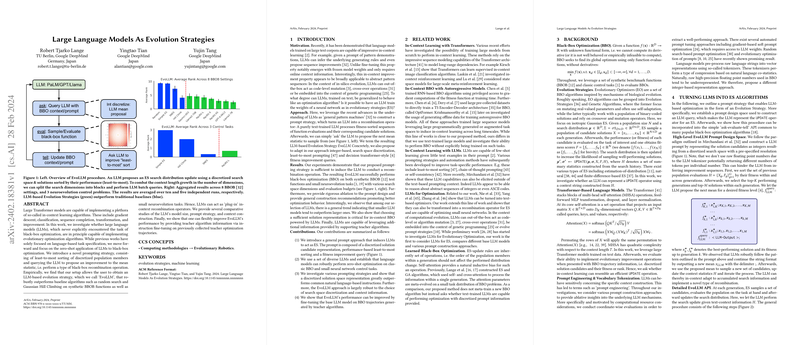LLMs as Evolvable Operators for Evolution Strategies
Evolution Strategies Leveraged by LLMs
This paper focuses on investigating the capability of LLMs to perform as operators within Evolution Strategies (ES), a subclass of evolutionary optimization algorithms. For this purpose, the authors have put forward a novel approach that utilizes large transformer-based models trained on vast text corpora, proposing that these models can, beyond language understanding and generation, also engage in optimization tasks without being explicitly trained for them. By introducing a tactic of discretized solution representation coupled with a heuristic least-to-most prompt strategy, this work explores the boundary of LLM application beyond traditional language tasks, steering towards optimization via evolutionary strategies.
Methodological Insights
The authors introduce a prompt-based strategy for leveraging LLMs in black-box optimization tasks. The method involves sorting solution candidates based on their fitness and requesting the LLM to propose the next mean statistic to sample from. The innovative aspect lies in representing the solution space in a discretized format conducive to LLM processing capabilities, suggesting a potential paradigm where LLMs act as 'plug-and-play' operators for ES. This paper challenges the conventional understanding by showing smaller LLM models could outperform larger counterparts in tasks of evolutionary optimization, a finding contrary to the prevailing wisdom in LLM applications to natural language processing.
Experimental Demonstrations and Results
The empirical verification involved testing the designed EvoLLM model across synthetic benchmark functions and neuroevolution tasks. The results are impressive, with the EvoLLM outperforming baseline algorithms such as random search and Gaussian Hill Climbing across diverse tasks. These results also highlighted a remarkable aspect of LLM performance, where model size inversely correlated with optimization efficiency within the evolutionary strategies framework. Additionally, fine-tuning the underlying LLM models using trajectories generated by 'teacher' optimization algorithms has shown potential in enhancing EvoLLM's performance, indicating the possibility of tailored LLM applications through appropriate instructional tuning.
Implications and Speculations
The findings imply a broader applicability of LLMs beyond their conventional scope, suggesting their viability as generic pattern recognition and improvement engines, even in domains discreet from natural language. This could potentially pave the way for LLMs to contribute significantly to the field of optimization, particularly in ES and related evolutionary algorithms. One could speculate on the future development of more specialized LLMs or prompt strategies tailored for numerical optimization tasks, potentially extending the utility of LLMs across various scientific and engineering disciplines requiring optimization solutions.
Challenges and Directions for Future Research
Despite the promising findings, the work also outlines limitations related to pretraining, fine-tuning, and contextual understanding of LLMs when applied to numerical optimization tasks. The apparent inversion of the scaling law observed, where smaller models outperformed larger ones in optimization tasks, opens up intriguing questions regarding the underlying mechanics of LLMs in non-linguistic applications. Future research directions could focus on a deeper understanding of these phenomena, development of benchmarks specific to LLM-driven optimization, and exploration into evolving tokenization techniques that are more amenable to numerical representations.
Ethical and Monitoring Considerations
Given the exploration of LLMs in autonomous optimization, ethical considerations and monitoring of their operational boundaries become paramount. Ensuring responsible use and understanding the implications of deploying such powerful models in autonomous or semi-autonomous decision-making processes is critical to mitigate undesired consequences or exploitations.
In conclusion, this paper embarks on an exploratory journey, expanding the horizons of LLM applications into evolutionary strategies and optimization, opening up novel avenues for research and application of generative AI models.
